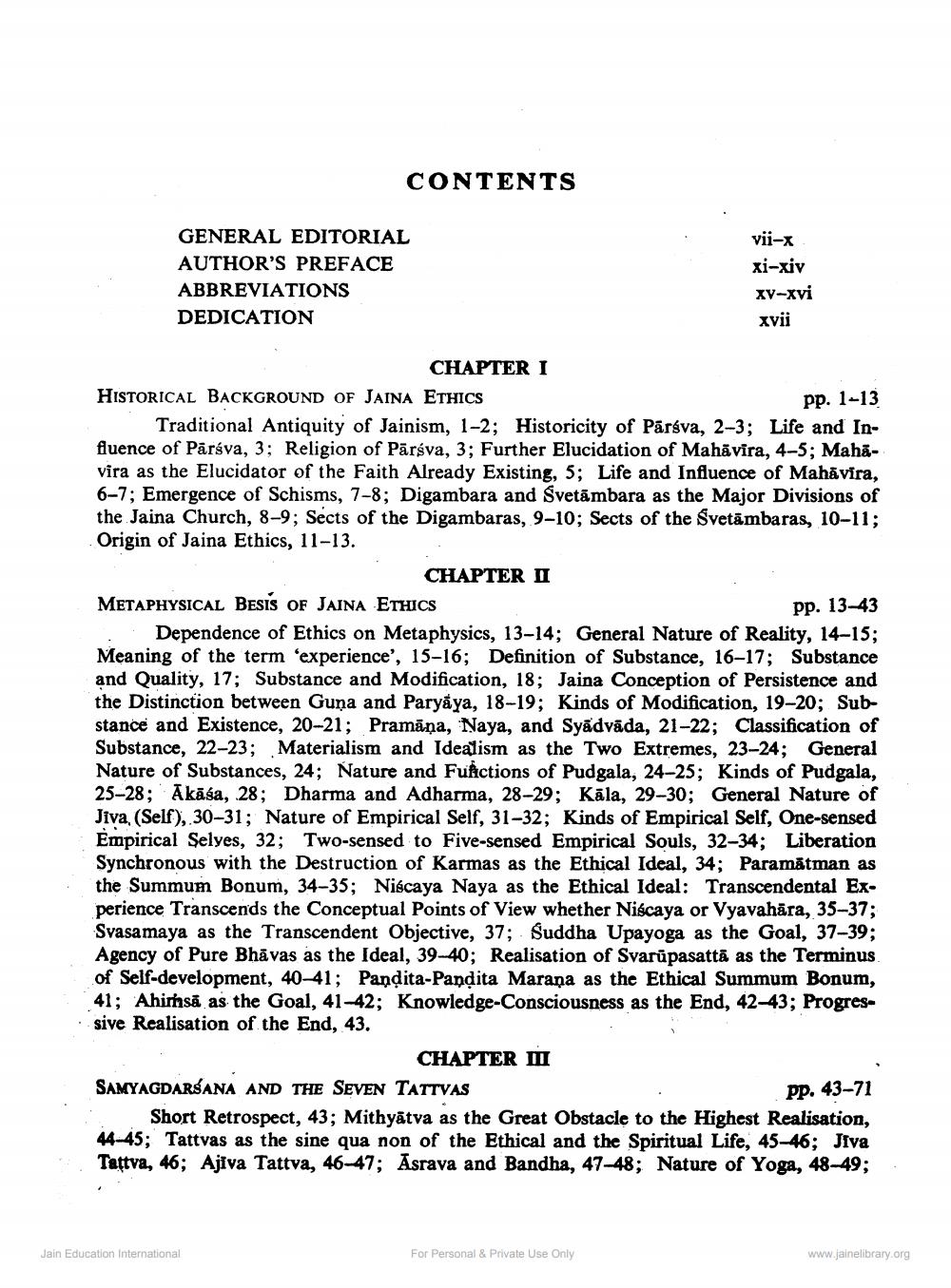Book Title: Ethical Doctrines in Jainism Author(s): Kamalchand Sogani Publisher: Jain Sanskruti Samrakshak Sangh Solapur View full book textPage 5
________________ CONTENTS GENERAL EDITORIAL AUTHOR'S PREFACE ABBREVIATIONS DEDICATION vii-x xi-xiv XV-Xvi xvii CHAPTER 1 HISTORICAL BACKGROUND OF JAINA ETHICS pp. 1-13 Traditional Antiquity of Jainism, 1-2; Historicity of Pārsva, 2-3; Life and Influence of Pārsva, 3; Religion of Pārsva, 3; Further Elucidation of Mahāvira, 4-5; Mahāvira as the Elucidator of the Faith Already Existing, 5; Life and Influence of Mahāvīra, 6-7; Emergence of Schisms, 7-8; Digambara and Svetāmbara as the Major Divisions of the Jaina Church, 8-9; Sects of the Digambaras, 9-10; Sects of the Svetāmbaras, 10-11; Origin of Jaina Ethics, 11-13. CHAPTER I METAPHYSICAL Besis of JAINA ETHICS pp. 13-43 . Dependence of Ethics on Metaphysics, 13-14; General Nature of Reality, 14–15; Meaning of the term 'experience', 15-16; Definition of Substance, 16-17; Substance and Quality, 17; Substance and Modification, 18; Jaina Conception of Persistence and the Distinction between Guna and Paryāya, 18-19; Kinds of Modification, 19-20; Substance and Existence, 20-21; Pramāņa, Naya, and Syādvāda, 21-22; Classification of Substance, 22-23; Materialism and Idealism as the Two Extremes, 23-24; General Nature of Substances, 24; Nature and Fußctions of Pudgala, 24-25; Kinds of Pudgala, 25-28; Ākāśa, 28; Dharma and Adharma, 28-29; Kāla, 29-30; General Nature of Jiva (Self), 30-31; Nature of Empirical Self, 31-32; Kinds of Empirical Self, One-sensed Empirical Selyes, 32; Two-sensed to Five-sensed Empirical Souls, 32-34; Liberation Synchronous with the Destruction of Karmas as the Ethical Ideal, 34; Paramātman as the Summum Bonum, 34-35; Niscaya Naya as the Ethical Ideal: Transcendental Experience Transcends the Conceptual Points of View whether Niscaya or Vyavahāra, 35-37; Svasamaya as the Transcendent Objective, 37; Suddha Upayoga as the Goal, 37-39; Agency of Pure Bhāvas as the Ideal, 39-40; Realisation of Svarūpasattā as the Terminus of Self-development, 40-41; Pandita-Pandita Marana as the Ethical Summum bonum, 41; Ahirhsā as the Goal, 41-42; Knowledge-Consciousness as the End, 42-43; Progressive Realisation of the End, 43. CHAPTER M SAMYAGDARSANA AND THE SEVEN TATTVAS pp. 43-71 Short Retrospect, 43; Mithyātva as the Great Obstacle to the Highest Realisation, 44-45; Tattvas as the sine qua non of the Ethical and the Spiritual Life, 45-46; Jiva Tattva, 46; Ajiva Tattva, 46-47; Asrava and Bandha, 47-48; Nature of Yoga, 48-49; ons of Kads Of Souls, BAPR ute of Empiricalharma, 28–20Pudgala, 24 Ideal, 32-2, One. he Ethic Jain Education International For Personal & Private Use Only www.jainelibrary.orgPage Navigation
1 ... 3 4 5 6 7 8 9 10 11 12 13 14 15 16 17 18 19 20 21 22 23 24 25 26 27 28 29 30 31 32 33 34 35 36 37 38 39 40 41 42 43 44 45 46 47 48 49 50 51 52 ... 322
